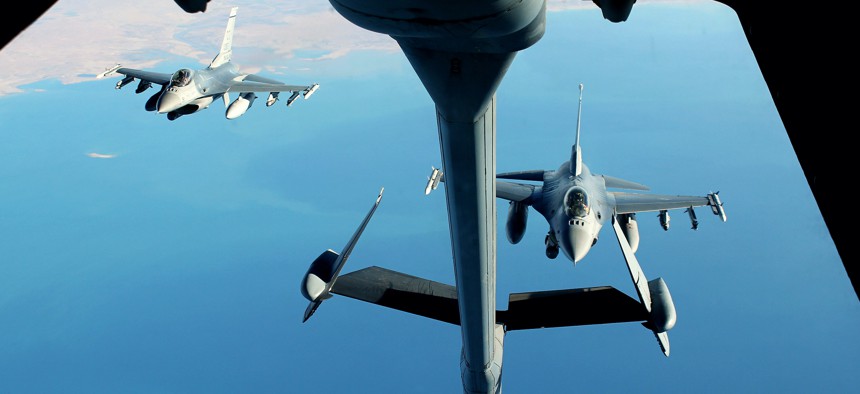
Two F-16 Fighting Falcons fly in formation behind a KC-10 Extender from Al Dhafra Air Base, United Arab Emirates, Dec. 25, 2021. U.S. Air Force / Master Sgt. Dan Heaton
Got Fuel? Fixing the US Military’s Aerial Refueling Architecture
Start by creating more hardened ground fuel dumps in the Pacific.
It’s a military pilot’s nightmare: you arrive for your airborne refueling but no one’s there—just empty sky above the ocean that will soon swallow your fuel-dry aircraft. That’s the situation U.S. pilots are likely to face in a conflict against China unless the Pentagon quickly makes some changes in its investment priorities and operational concepts.
Aerial refueling has long underpinned the U.S. military’s ability to promptly deploy forces and sustain operations at theater scales. But the Air Force’s tanker force has shrunk from 701 to 473 tankers over the past few decades and faces major readiness challenges, even as it continues to sustain an extraordinary pace of “normal” operations. Worse still, the People’s Republic of China is increasingly capable of attacking aircraft and airbases, which could attrite aircraft and force planners to fight in less effective and more predictable ways. DoD must quickly improve its aerial refueling architecture.
Start on the ground. If a conflict with China broke out tomorrow, U.S. air refueling operations would be limited most severely not by the tanker fleet but by the mere dozen or so Indo-Pacific airfields that have sufficient runway, ramp space, fuel stores—and whose governments can be expected to grant access. This vulnerable archipelago of fuel would support relatively few tankers to begin with, and fewer still after Chinese strikes begin.
Negotiating for new and repairing and expanding the capacity of existing airfields should therefore be a top Air Force priority, even if it comes at the cost of tanker procurement. We calculate that spending $633 million per year over the next decade (and $400 million thereafter) to Indo-Pacific posture and maritime tankers that can deliver fuel to airfields could boost employable tanker capacity in the theater by 63 percent within a decade and greatly improve operational resilience.
Also needed are improvements in command and control, communications, and fleet optimization tools. During peacetime, these could improve tanker availability and lower costs. During crises, they would increase tanker survivability and allow tankers to operate in a more distributed and agile manner on the ground and in the air.
Finally, adding cost-effective defensive systems to current and future tankers would allow them to deliver fuel closer to threats, thus maximizing the range and endurance of supported aircraft. The technologies for C3 and self-defense improvements are largely mature and could be adopted by the tanker fleet during the next five years.
Air Force leaders will also need to accelerate recapitalization of the aerial refueling fleet through the near-term KC-Y and medium-term K-Z tanker programs, given growing operational risks and competing demands on funding.
The top candidates for KC-Y are the Boeing KC-46A and the Lockheed Martin Next Generation Tanker (LMXT), a modified version of the Airbus A330 Multi Role Tanker Transport.
The LMXT can carry more fuel than the KC-46A, which could allow it to support missions with fewer aircraft, thus saving operating costs on some missions during peacetime and reducing operational complexity during crises or conflicts. And like the KC-10 that is being retired, the LMXT excels at the long-range, high-capacity offloads needed for large operations from distant airfields, such as those found throughout the Indo-Pacific.
But the smaller KC-46A requires less ramp space, which means that an all-Pegasus fleet might actually be able to deliver more fuel from a given base, albeit using more tankers and ground and air personnel. The KC-46A also likely costs less to procure and operate than the LMXT, and the U.S. Air Force could avoid incurring some costs by selecting the KC-46A and increasing tanker fleet commonality.
Throughout the 2020s, the U.S. Air Force can methodically fund technology maturation, design, and prototyping efforts to increase tanker survivability and launch a follow-on tanker program. The future tanker, termed K-Z(M), should likely occupy a medium-sized space on the airfield, be fuel-efficient, and be able to refuel at least six fighters or one transport aircraft at range. Because it would remain outside highly contested areas and could defend itself against some missiles through protection systems and a balanced approach to signature management, the K-Z(M) would not require a highly stealthy and expensive design.The possibility of making the K-Z(M) a highly automated unmanned aircraft should be examined for its operational and lifecycle cost benefits. Conversely, the U.S. Air Force should avoid small or very small designs that would carry insufficient fuel and depend on “shuttling” back and forth from a larger tanker, and very-low-observable tankers that would be expensive to develop and procure.
In 2022, the U.S. aerial refueling enterprise is losing altitude. The Air Force must act quickly to improve and replace its aging tanker fleet before its increasing operating and maintenance costs consume modernization funds—leaving a smaller, weaker aerial refueling force and in turn Joint Force.
Timothy A. Walton is a senior fellow at the Hudson Institute’s Center for Defense Concepts and Technology. He recently published a report with Bryan Clark titled "Resilient Aerial Refueling: Safeguarding the U.S. Military’s Global Reach."
NEXT STORY: A Joint Jump for US-UK Friendship Day



